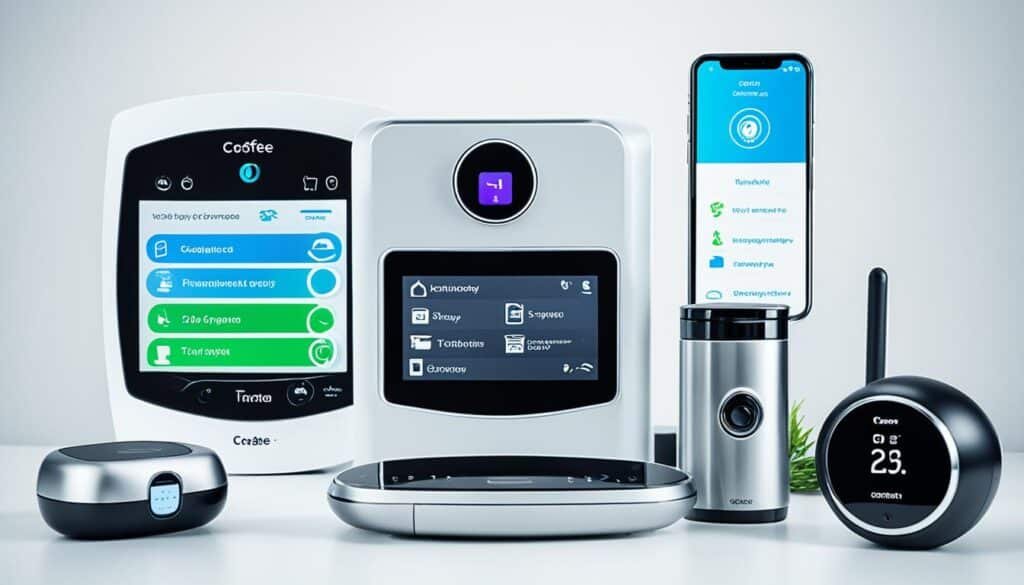The internet of things (IoT) is a network of devices that can share data. They do this without people needing to tell them to. These devices have sensors, software, and ways to connect to networks. This way, everything from your fridge to big machines can talk to each other and share info.
IoT helps businesses work better, make customers happier, and make smarter choices. It does this by giving them the data they need very quickly.
IoT is made of four main parts: sensors or devices, ways to connect, analyzing the data, and a user interface you can see. It’s used in many fields like farming, building, making home life easier, creating smart cities, health care, shops, moving things around, and managing energy.
Key Takeaways
- The internet of things (IoT) is a network of devices that can collect, share, and exchange data without human intervention.
- Devices in IoT have sensors, software, and ways to connect. This lets them talk and share data.
- IoT helps companies run smoother, increases customer satisfaction, boosts decision-making, and adds value to a business.
- The four essentials of IoT are sensors or devices, connection tools, data understanding, and an interface for humans.
- It’s used in many areas including farming, making homes smarter, health care, and improving how we move things around.
Understanding the Internet of Things
The internet of things (IoT) is a fast-growing collection of devices and systems. They have sensors, software, and ways to connect to the internet. This lets them gather, share, and understand data on their own. These devices range from simple home gadgets to complex industrial machines.
What Is the Internet of Things?
Essentially, the internet of things is about linking devices and systems to the web. It lets them talk and exchange data with each other and online platforms. This connection helps businesses work better, improve customer service, and make smarter choices. It does this by giving access to live data and insights.
In an IoT setup, the important parts are the sensors or devices, the connection, the data analysis, and a friendly interface. These IoT devices produce tons of data. This data is then looked at to find useful insights and create new IoT applications.
We often hear the term IoT used to talk about a growing network of connected devices and systems. This network is changing how we live, work, and engage with the world. As more IoT devices join the mix, the internet of things offers new and bigger benefits.
“The internet of things has the potential to change the world, just as the internet did. Maybe even more so.”- Satya Nadella, CEO of Microsoft
Components of an IoT System
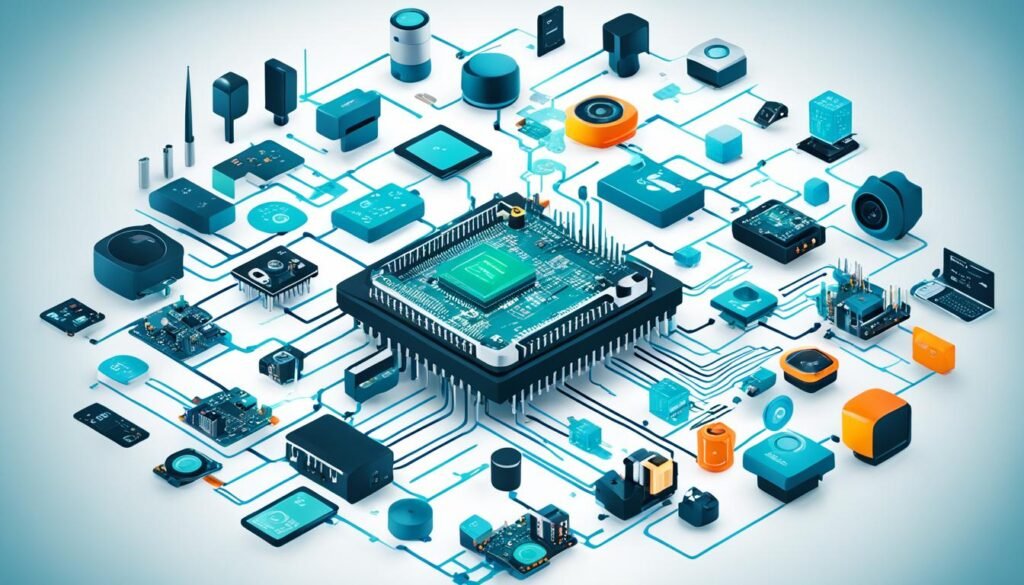
The Internet of Things is made up of many parts. These parts work together to collect, send, and look at data from the physical world. The heart of an IoT system is the iot sensors and iot devices. They get info about the environment, which includes everything in the Internet of Things.
Sensors or Devices
IoT sensors or devices are physical things that can connect to the web. They grab useful data from around them. These connected iot devices check things like how hot or cold, how wet, if there’s movement, or where something is. This digitizes the real world, letting the iot system watch, think about, and react to what’s happening around them.
Connectivity
The second key part of an IoT system is connectivity. It helps iot sensors and iot devices talk to each other and to the cloud. Various ways help with this, like Wi-Fi, Bluetooth, cell networks, and LPWAN. This lets iot devices send their data to the cloud. There, the data can be looked at to find useful info.
The smooth connection from iot devices to the cloud is vital for IoT. It allows for watching things in real time, controlling from far away, and making decisions based on what the iot sensors find.
| IoT Component | Description |
|---|---|
| Sensors or Devices | Web-enabled physical devices that collect data from the environment, such as temperature, humidity, motion, location, and more. |
| Connectivity | The ability of IoT devices to communicate with each other and the cloud over various network protocols and technologies, such as Wi-Fi, Bluetooth, cellular, and LPWAN. |
| Data Analysis | The process of extracting meaningful insights from the data collected by IoT sensors and devices, enabling informed decision-making. |
| User Interface | The graphical interface that allows users to interact with the IoT system, view data, and control connected devices. |
Learning about IoT’s main parts helps businesses and people use its power well. This leads to coming up with new ideas, working better, and finding great chances in many fields and areas.
Internet Of Things Applications
The Internet of Things (IoT) has changed how we engage with our surroundings. It covers many sectors and opens new doors. This tech not only makes our lives better but also affects industries and our daily routines. Let’s look at some big fields that use IoT.
Farmers use IoT to collect information on the weather and soil. This helps them grow crops better and take care of their animals. IoT is also big in making sure our buildings and roads are safe by keeping an eye on their condition in real time.
At home, IoT lets us manage our systems like heating and lights from afar. It brings us more comfort and saves energy.
- Smart cities use IoT to look after things like traffic and waste better. This makes life nicer for all of us.
- In health, doctors can use IoT to watch their patients closely from a distance. This smart tech makes medicine more personal and efficient.
- Shops are using IoT to understand how we move around their stores and what we like to buy. This helps them stock better and catch our interest.
- IoT in transportation improves how vehicles run and how they get us our stuff. It makes shipping goods smoother and our rides more efficient.
These examples just scratch the surface of what IoT can do. As it grows, there will be more cool ways it changes how we do things and improves our lives.
| Industry | IoT Application | Benefits |
|---|---|---|
| Agriculture | Sensor-based monitoring of environmental conditions and livestock health | Automated farming techniques, optimized irrigation, and improved animal welfare |
| Construction | Structural health monitoring of buildings, bridges, and infrastructure | Enhanced safety, predictive maintenance, and operational efficiency |
| Home Automation | Remote control and automation of home systems (e.g., thermostats, lighting, security) | Increased energy efficiency, convenience, and home security |
| Smart Cities | Monitoring and management of urban systems (e.g., traffic, parking, waste) | Improved resource allocation, reduced environmental impact, and enhanced quality of life |
| Healthcare | Remote patient monitoring, smart medical devices, and medication tracking | Personalized care, better health outcomes, and increased medication adherence |
| Retail | Tracking customer movement, analyzing shopping patterns, and managing inventory | Improved customer experience, optimized operations, and more effective marketing |
| Transportation | Vehicle performance monitoring, route optimization, and shipment tracking | Enhanced efficiency, reduced costs, and improved logistics |
The use of IoT is vast and impactful. As it moves forward, we’ll see more ways it changes the game and boosts our daily life quality.
“The Internet of Things has the potential to change the world, just as the Internet did. Maybe even more so.”
Benefits of IoT for Organizations
The Internet of Things (IoT) is a game-changer for many businesses. It brings two main benefits: making operations more efficient and offering valuable insights through data.
Operational Efficiency
IoT allows companies to automate tasks, lower labor costs, and boost service quality. Devices can handle repetitive jobs without needing humans, making operations more efficient. This efficiency cuts waste and uses resources more wisely.
Data-Driven Insights
IoT provides real-time data on how systems and processes are performing. This data helps organizations make better choices, improve how they work, and create new strategies. With IoT, companies can study huge amounts of data to spot important trends and stay ahead of their competition.
Moreover, IoT can make communication better, help with getting information easily, and save money for organizations. As the digital world evolves, using IoT has become key for many companies to transform their operations.
| Benefit | Description |
|---|---|
| Operational Efficiency | IoT enables automation, reduces labor costs, and improves service delivery. |
| Data-Driven Insights | IoT provides real-time data and insights for informed decision-making. |
| Enhanced Communication | IoT improves connectivity and access to information within the organization. |
| Cost Savings | IoT solutions can lead to reduced operational expenses and increased efficiencies. |
“IoT is essential for businesses looking to stay competitive and drive digital transformation.”
Industrial Internet of Things (IIoT)
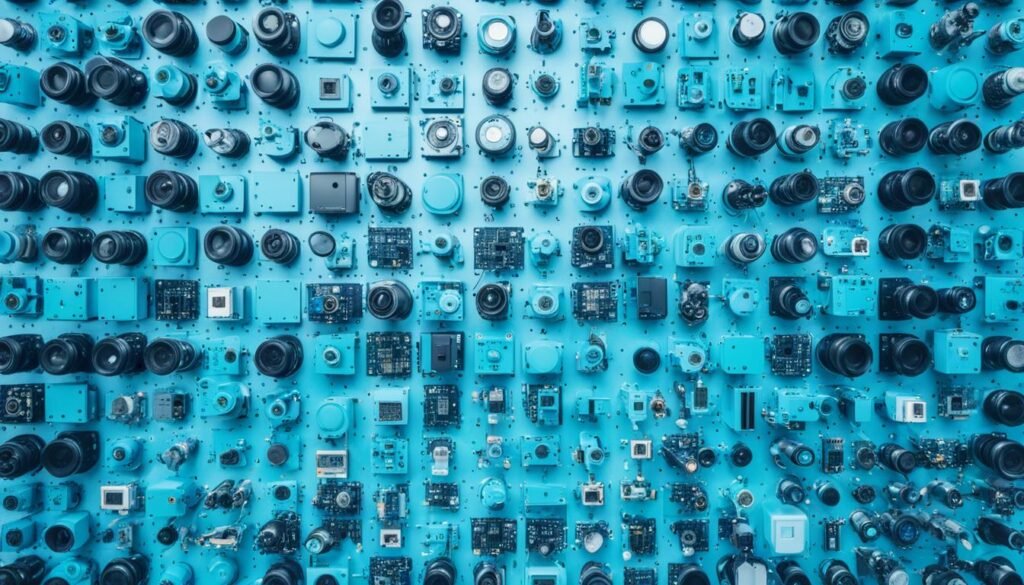
The Industrial Internet of Things (IIoT) is the use of IoT technologies in places like factories, stores, and hospitals. It involves IIoT devices like sensors and machines. These devices gather and share data to improve how businesses work.
Key applications of IIoT are:
- Manufacturing: It uses advanced tech to predict and prevent machine failures. This cuts down on time lost and keeps workers safe.
- Automotive: Cars use sensors and robots to do better in making and fixing them.
- Logistics and transportation: It helps move things smarter, like tracking inventory and finding the best routes.
- Retail: The focus is on making storage automated and helping machines and people work together.
IIoT helps businesses by offering quick IoT data and insights. This makes things run smoother, spend less money, and make more profits. It uses IoT devices and IoT technologies to make industrial IoT devices work better. This opens the door for more IoT uses in many fields.
| Industry | IIoT Application | Benefits |
|---|---|---|
| Manufacturing | Predictive Maintenance | Less waiting time, safer work |
| Automotive | Sensor-driven Analytics | Better at making and fixing cars |
| Logistics and Transportation | Managing Supplies, Tracking Inventory | Smart routes, more visible actions |
| Retail | Automatic Warehouses, Working with Machines | Do more, use less work |
“The Industrial Internet of Things is changing how businesses work. It pushes efficiency, productivity, and new ideas.”
Adding IoT devices and IoT technologies lets companies use industrial IoT. That gives businesses an edge and creates new chances.
IoT Security and Privacy Concerns
The Internet of Things (IoT) is changing our world in many ways. But along with these changes come new security and privacy concerns. IoT gadgets are made to gather and share a lot of data. Yet, they often lack good security, making them targets for online hackers.
Hackers might use these devices to enter big systems and cause various troubles. These could include stealing data, stopping activities, or taking over physical machines. With so many IoT devices around, the risk is even higher from these attackers.
Keeping our private info safe is also a tricky issue with IoT security and privacy. These gadgets gather all sorts of personal data, from what we do to where we are, and even our biometric information. If this data falls into the wrong hands, it can lead to privacy violations and put us in danger.
We have to take steps to tackle these IoT security and privacy issues. This means focusing on making IoT devices secure from the start, using encryption, and looking out for and fixing any security holes. Plus, educating users on how to keep their devices safe is crucial.
| IoT Security Challenges | IoT Privacy Concerns |
|---|---|
|
|
While the IoT ecosystem keeps growing, we can’t overlook these security and privacy issues. Making IoT devices safer lets us fully enjoy the benefits of the Internet of Things without the dangers. We all must do our part in keeping these new technologies secure.
“The security and privacy of IoT devices is a critical issue that must be addressed as the technology continues to evolve and become more widely adopted.” – Industry Expert
Future of the Internet of Things
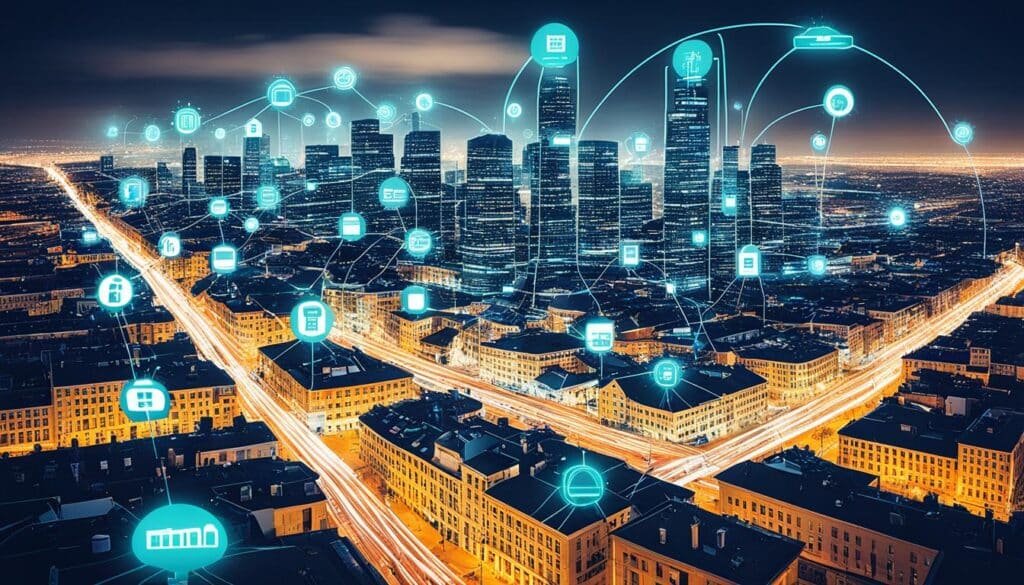
The future of the Internet of Things (IoT) is bright, with growth and adoption expected to continue. By 2025, the number of IoT-connected devices should hit 27 billion. This huge jump from 12 billion in 2021 shows how more people and companies see the value of these technologies.
Growth and Adoption
As the IoT market grows, more industries will adopt IoT devices and solutions. This is especially true in the enterprise IoT sector. Businesses are using IoT to improve operational efficiency, get data-driven insights, and foster innovation.
Emerging Technologies
The future of the Internet of Things will also be influenced by new advanced technologies. These advancements include:
- 5G and Cellular IoT: 5G networks will boost connectivity for IoT devices. This will create new possibilities and improve existing applications.
- Edge Computing: By processing data closer to devices, edge computing will make IoT faster and more responsive.
- Artificial Intelligence (AI) and Machine Learning (ML): AI and ML in IoT systems will enable automatic decisions and predictive insights.
- Blockchain: Blockchain will improve the security and transparency of IoT networks. This will be crucial in sectors like supply chain management and smart cities.
These emerging technologies will keep advancing and joining with the Internet of Things. This will make the future of IoT even smarter, more innovative, and transformative for everyone.
“The Internet of Things is not just about connecting devices; it’s about enabling the Internet of Everything – a world where physical and digital converge to create new opportunities for growth, innovation, and transformation.”
Consumer IoT Devices
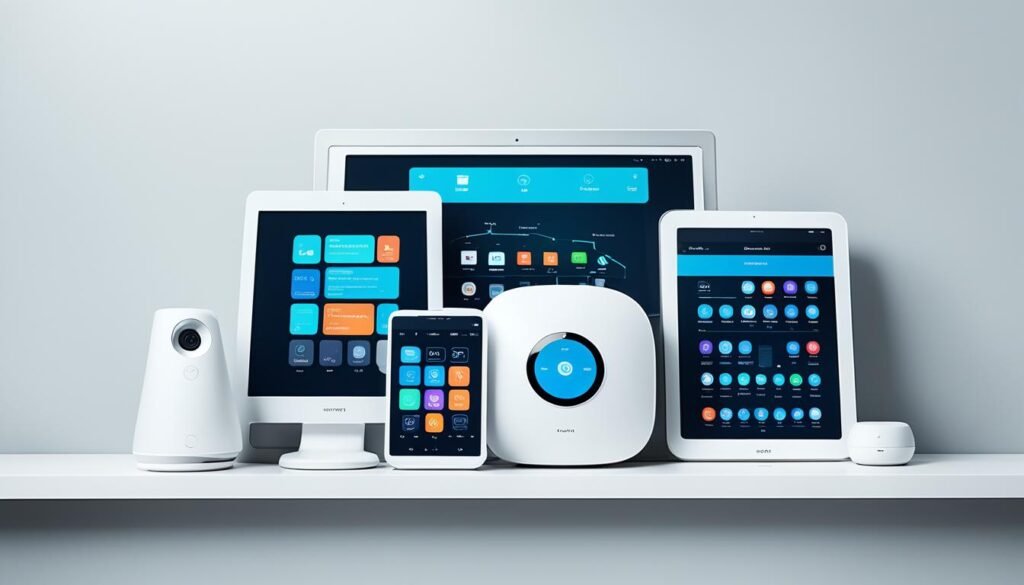
The Internet of Things (IoT) has changed how we use gadgets. This technology has brought us a wide range of connected devices for daily activities. These consumer IoT devices are making our homes smart, helping us keep an eye on our health, and adding fun to our lives.
Among the popular consumer IoT devices are smart home gadgets. These include thermostats, security systems, lighting, appliances, and voice assistants. You can control them from afar. There are also wearable devices like fitness trackers and smartwatches. They track your activity and health stats to give you health tips.
In the home entertainment sector, there are smart TVs, game consoles, and streaming devices. They’re now IoT-ready. This means you can easily get content and connect with other devices. We’re also seeing more connected cars and electric vehicles. They offer remote checks and work with your smart home.
These gadgets are not just for fun. They’re growing the IoT ecosystem too. As more people use IoT devices, we expect these gadgets’ worth to increase. They are designed to help us more, work efficiently, and offer insights to make our lives better.
Challenges in IoT Implementation
Internet of Things (IoT) has its share of benefits and challenges. One major challenge is security and privacy. Most IoT devices lack security, making them easy targets for cyber threats. This situation allows hackers to enter and control larger systems through these devices.
Handling the huge amounts of data IoT devices create is another issue. It demands strong data management and analytic skills. Companies need the right tools and people to make use of this data for making smart decisions.
Integrating IoT with current technology and operations is tough and time-consuming. It involves dealing with old systems, compatibility, and the need for special knowledge to solve issues. A smart and planned effort on IoT security and data management is needed to succeed.
The road isn’t easy, but the IoT is promising for many industries. By focusing on security and privacy and improving data management, companies can fully benefit from the Internet of Things.
| Key Challenges in IoT Implementation | Description |
|---|---|
| Cybersecurity Risks | IoT devices are vulnerable to cyber threats, which can be used as entry points for hackers to access larger networks and disrupt operations or steal data. |
| Data Management and Analytics | The vast amounts of data generated by IoT devices can be challenging to manage and analyze, requiring robust data management and analytics capabilities. |
| Integration with Existing Systems | Integrating IoT systems with legacy technologies and processes can be complex, time-consuming, and require specialized expertise. |
To win in the IoT world, companies must focus on cybersecurity, strong data management, and smooth integration. Overcoming these hurdles will help businesses grab the opportunities the Internet of Things offers, fostering growth and new ideas.
Also Read: How Secure Is Cloud Computing For Data Storage?
Conclusion
The Internet of Things (IoT) has changed how we see the world. It connects many devices and sensors. This allows for the gathering of data, its quick analysis, and automation. These steps are changing industries and making our lives better. We see this in smart home tools and industrial automation, among others. The uses of IoT keep growing.
As more IoT devices come out, they bring great value to both businesses and people. They make work more efficient, give deep insights from data, and help create new products and services. At the same time, they give people more control, make life more convenient, and boost security. This trend is due to the expanding number of IoT devices.
Yet, using IoT widely also faces hurdles, like privacy and security fears. Despite these issues, the good things about this technology are greater. Thanks to better network rules, data control, and machine learning, IoT’s future is bright. It will offer many chances for personal, business, and community development.
FAQs
Q: What is the Internet of Things (IoT)?
A: The Internet of Things refers to a network of internet-connected devices that can communicate and exchange data with each other. These devices can range from smart home gadgets to industrial sensors.
Q: How does the Internet of Things work?
A: IoT devices are equipped with sensors and actuators that allow them to collect data and perform actions based on that data. This data is then transmitted to an IoT platform where it is processed and analyzed.
Q: What are some examples of IoT devices?
A: Examples of IoT devices include smart thermostats, wearable fitness trackers, security cameras, industrial sensors, and connected vehicles.
Q: How can businesses benefit from using IoT?
A: Businesses can leverage IoT technologies to improve efficiency, monitor operations in real-time, optimize resource utilization, and enhance decision-making processes.
Q: What are some common applications of IoT in industries?
A: Industrial IoT (IIoT) is used in sectors such as manufacturing, healthcare, agriculture, logistics, and energy to streamline processes, enhance productivity, and enable predictive maintenance.
Q: What is the significance of IoT platform in IoT deployments?
A: IoT platforms act as the middleware that connects IoT devices to applications and enables data processing, storage, and integration with other systems.
Q: How does IoT contribute to the concept of smart devices?
A: IoT technologies enable the development of smart devices that are capable of automation, remote monitoring, data analytics, and connectivity to enhance user experience and functionality.
Source Links
- https://aws.amazon.com/what-is/iot/
- https://www.techtarget.com/iotagenda/definition/Internet-of-Things-IoT
- https://builtin.com/internet-things

